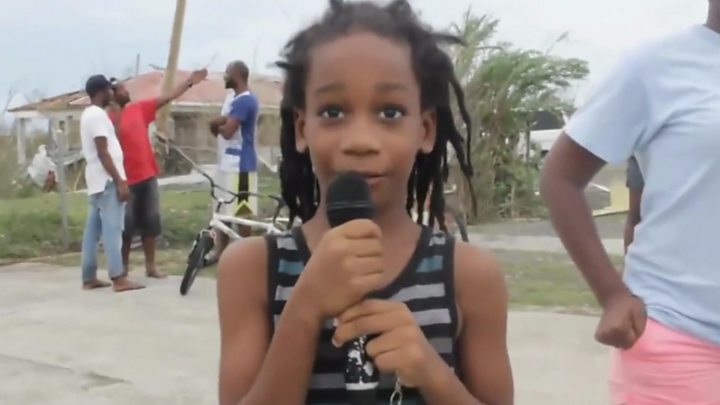
Hurricane Irma has caused widespread destruction across the Caribbean, reducing buildings to rubble and leaving at least nine people dead.
The small island of Barbuda is said to be "barely habitable". Officials warn that St Martin is almost destroyed, and the death toll is likely to rise.
Irma is a category five hurricane, the highest possible level.
It is currently north of the Dominican Republic, heading towards Turks and Caicos.
The low-lying Turks and Caicos islands, a British overseas territory, are said to be at risk of a storm surge, with the possibility of destructive waves up to 6m (20ft) higher than usual.
Virginia Clerveaux, director of the Turks and Caicos Department of Disaster Management and Emergencies, told the BBC that even inland areas could be inundated.
"We are now trying to remind them [the people of the islands] that this is a category 5, and in the history of the Turks and Caicos islands this is the largest storm we have ever been impacted or threatened by.
"So there is a need to ensure that we have maximum preparations in place... We have been saying to persons to ensure that they are prepared, ensure they can shelter safely, they have sufficient food and drinking water for two to three days."
Meanwhile, the head of the US emergency agency has said that Hurricane Irma will have a "truly devastating" impact when it hits southern coastal areas of the United States.
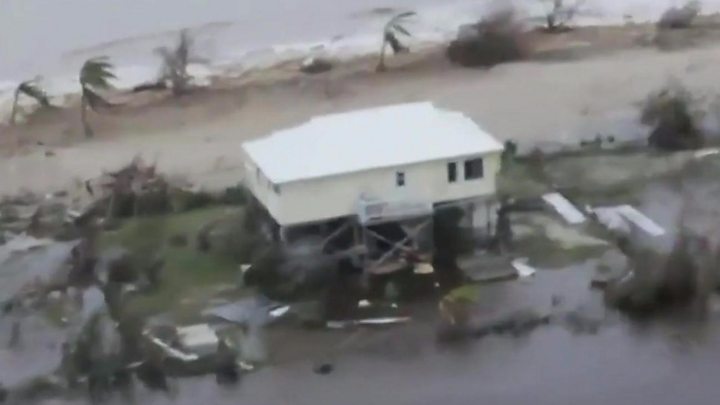
"The majority of people along the coast have never experienced a major hurricane like this," Federal Emergency Management Agency (Fema) chief Brock Long told CNN.
The most powerful Atlantic storm in a decade, Irma has sustained wind speeds of 285km/h (180mph).
What are the worst-hit areas?
Hurricane Irma first struck the dual-island nation of Antigua and Barbuda. At least one death, of a child, was reported on Barbuda, where Prime Minister Gaston Browne said about 95% of the buildings had suffered some damage.
"It's absolute devastation," he said after flying over the island, home to some 1,600 people. "The island is literally under water. In fact, I'm of the view that, as it stands now, Barbuda is barely habitable."
He told the BBC that 50% of the Barbuda population were now homeless and that it would cost $100m (£80m) to rebuild the island.
However, Antigua, with a population of 80,000, escaped major damage, with no loss of life, he said earlier.
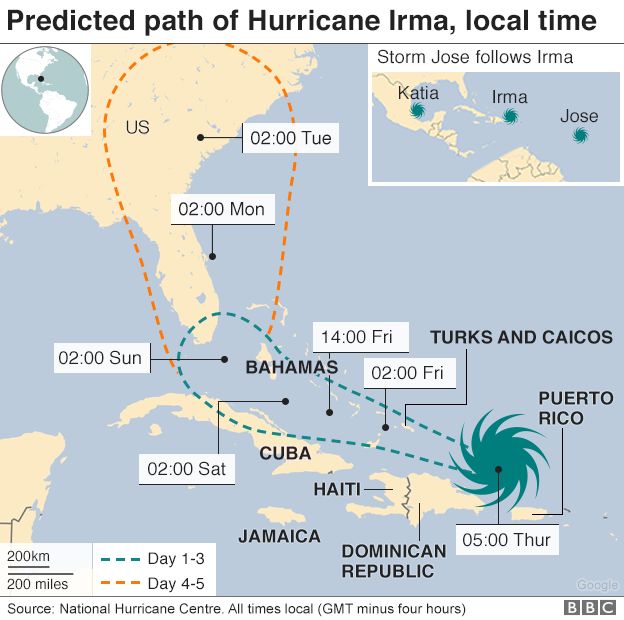
St Martin, an island that comprises the French territory of Saint-Martin and the Dutch section Sint-Maarten, suffered terrible damage.
French officials have confirmed at least four deaths in Saint-Martin, down from an earlier reported death toll of eight.
"It's an enormous catastrophe - 95% of the island is destroyed," top local official Daniel Gibbs said of Saint-Martin.
Sint-Maarten's airport, the third largest in the Caribbean, has been seriously damaged.
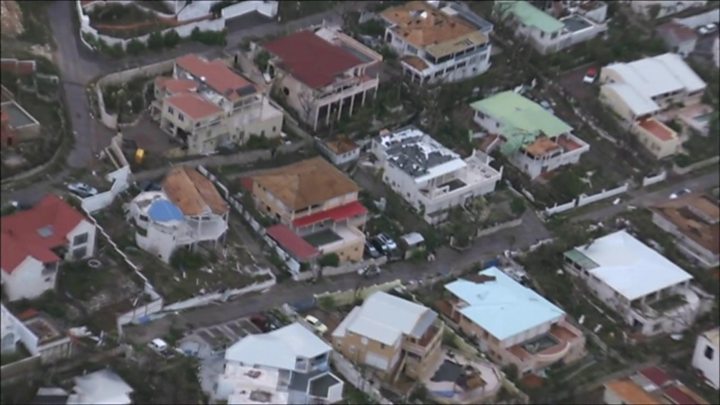
The Dutch defence ministry said: "The picture is of many uprooted trees, houses without roofs and pleasure boats on land."
The Dutch navy has sent two ships from nearby Aruba and Curacao to assist locals but they have had trouble docking, according to media in the Netherlands.
Dutch Prime Minister Mark Rutte said: "The island is not reachable at this point because of the huge damage to the airport and the harbour."
French Interior Minister Gerard Collomb said efforts were under way to get supplies to Saint-Martin and Saint Barthélemy.
"There is massive destruction. We'll concentrate our first efforts so that in the next hours people can get access to food and drinking water," he told reporters.
At least three people had died in Puerto Rico, the governor's office said.
The US territory's capital, San Juan, saw waves of up to 30ft. More than 6,000 residents are in shelters, and many more are without power.
Where else has been hit?
British overseas territories Anguilla and the British Virgin Islands were also caught in the extreme weather.
At least one death has been reported on Anguilla, a local official confirmed.

One Anguilla resident told the BBC the island looked as if it had been struck by a nuclear bomb, with roofs torn off many of the main buildings, including the hospital.
Some residents complained that the UK response was inadequate.
British Defence Secretary Michael Fallon said the UK had already positioned a landing ship, RFA Mounts Bay, in the disaster zone and its personnel were helping local authorities restore water and sanitation, supply shelter to those made homeless, and offer medical assistance if required.
Sir Michael said he had now ordered the deployment of a task group to the region and a second vessel, the helicopter carrier HMS Ocean, was being sent.
"Government is working together to support those affected by some of the strongest storms ever seen," he said in a statement. "We know people need help, we have prepared for this and we are putting those plans into action."
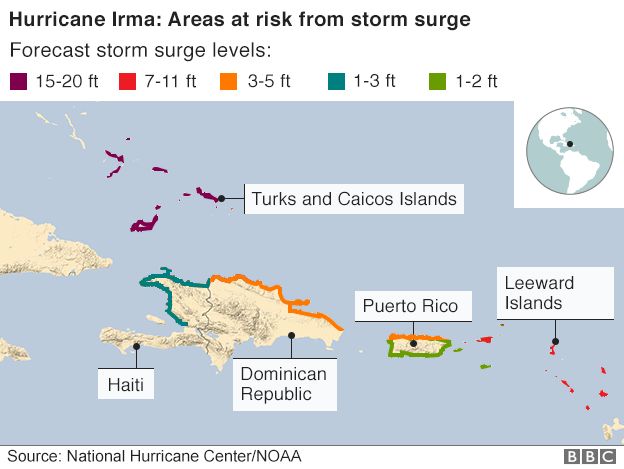
En route to the US
US President Donald Trump said he and his aides were monitoring Irma's progress. "But it looks like it could be something that will be not good," he told reporters at the White House. "Believe me, not good."
Projections suggest it could hit the state of Florida on Sunday.
Officials started evacuations of tourists and residents of Florida Keys, a resort archipelago.
Flights to and from several airports in Florida were being suspended, while Orlando's international airport said that commercial flights would stop from 17:00 local time on Saturday.
A state of emergency had been declared for Florida, Puerto Rico and the US Virgin Islands, mobilising federal disaster relief efforts.
Islands still at risk from Irma
Dominican Republic
- Population: 10.2 million
- Key facts: major tourist destination, shares island of Hispaniola with Haiti
- Hurricane prediction: Irma expected to pass close by
Haiti
- Population: 10.2 million
- Key facts: on the same island as the Dominican Republic; devastated by an earthquake in 2010
- Hurricane prediction: not directly in the hurricane's path, but remains on alert
Turks and Caicos
- Population: 31,500
- Key facts: enjoys one of the more dynamic economies in the region thanks to upmarket tourism, offshore finance and fishing
- Hurricane prediction: the low-lying region is at risk of a storm surge with destructive waves up to 6m (20ft) higher than usual possible
Cuba
- Population: 11 million
- Key facts: one of the world's last planned economies; a producer of sugar, tobacco and coffee, with a big tourism industry
- Hurricane prediction: Tropical storm conditions expected to begin on Thursday night (local time)
Bahamas
- Population: 350,000
- Key facts: an archipelago of more than 700 islands and islets, which attracts millions of tourists per year
- Hurricane prediction: warnings for north-west, south-east and centre; some areas have risk of storm surge of up to 6m (20ft)
Are there more hurricanes to come?
Another storm, Jose, further out in the Atlantic behind Irma, swelled to category one hurricane strength and could be near major hurricane strength on Friday, according to the US National Hurricane Center.
Forecasters say Jose is expected to pass close to the Leeward islands, a collective name for islands from Dominica to Puerto Rico. Its exact path is as yet unclear but winds are not expected to be as strong. However, it may hit areas already devastated by Irma.
Storm Katia, in the Gulf of Mexico, was also upgraded to hurricane status, and a warning was in effect for the coast of the Mexican state of Veracruz.
Seeing multiple storms developing in the same area of the Atlantic in close succession is not uncommon at this time of year. Rarer though is the strength of the hurricanes.
Hurricane Harvey made landfall in the US as a category four less than two weeks ago. Irma is expected to be at least category four when it arrives in the US.
There have never been two category four storms making landfall on the US mainland within the same season, since records began.

Are you in the region? Are you a holidaymaker unable to get a flight home or a resident who has been preparing for Hurricane Irma? If it is safe for you to do so, share your experiences by emailing haveyoursay@bbc.co.uk.
Please include a contact number if you are willing to speak to a BBC journalist. You can also contact us in the following ways:
- WhatsApp: +447555 173285
- Tweet: @BBC_HaveYourSay
- Send pictures/video to yourpics@bbc.co.uk
- Upload your pictures / video here
- Send an SMS or MMS to 61124 or +44 7624 800 100
- Hurricane Irma: 'It was like a horror movie'
- In pictures: Irma ravages Caribbean
- Hurricane Irma: 'UK doing all it can to help British territories victims'
- Hurricane Irma: Barbuda 'barely habitable', says PM
- Hurricane Irma: Visual guide
- Travel disruption as Hurricane Irma forces flight cancellations
- Hurricane Irma: Fears grow for Britons in Caribbean
- Hurricane Irma heads for Turks and Caicos
- Houston floods: Uninsured and anxious, victims return home
- Hurricane Irma: 'I think it will be catastrophic'
- Hurricane Harvey: Texas governor warns bill could be $180bn
- How hard has Hurricane Harvey hit the local economy?
- Hurricane Harvey: Four key effects of Houston floods


No comments:
Post a Comment